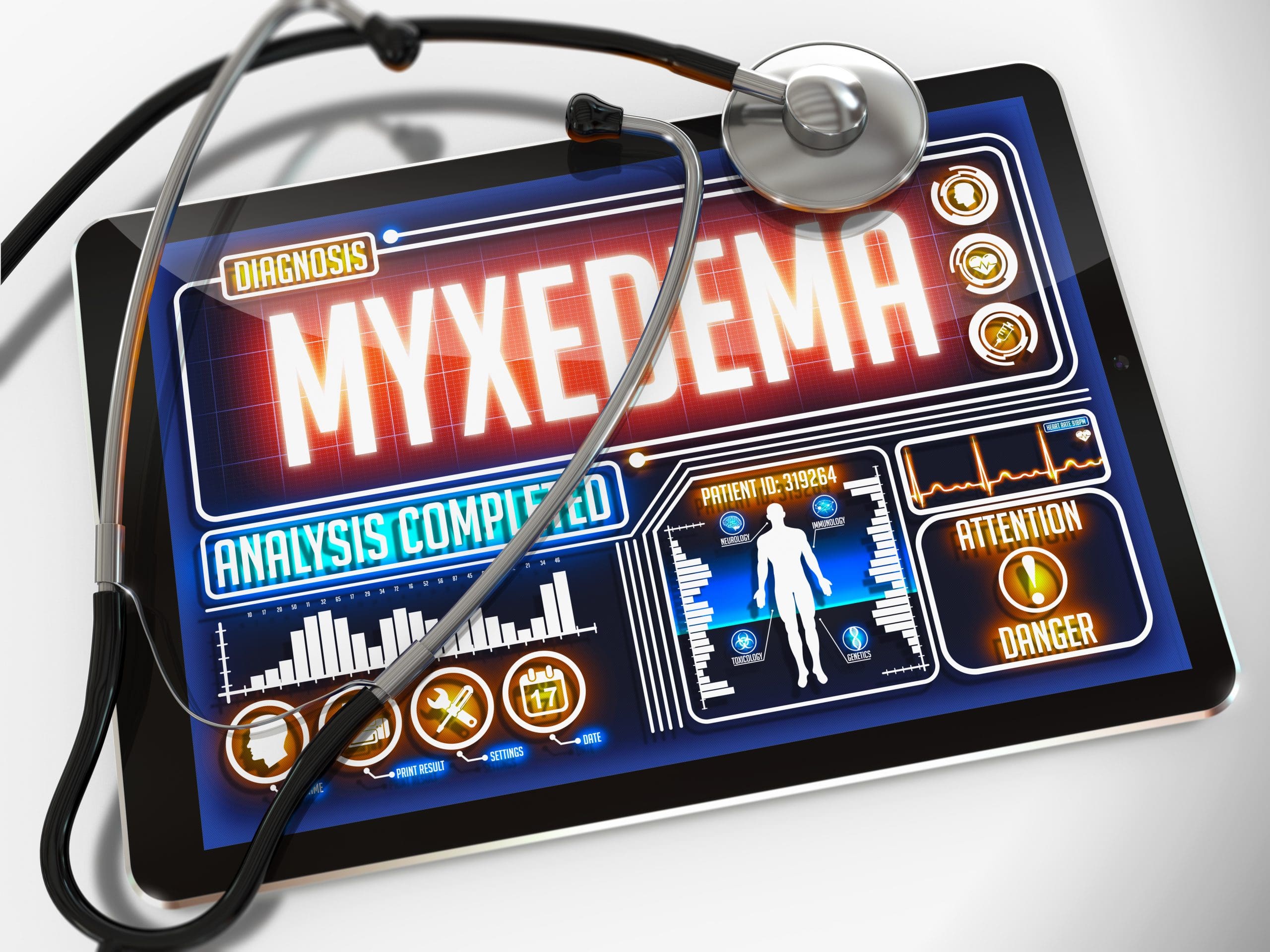Emergent and aggressive treatment are key to a good outcome.
Takeaways:
- Myxedema coma is the most severe, potentially life-threatening form of hypothyroidism and a medical emergency.
- Myxedema coma frequently results from untreated or undertreated hypothyroidism.
- Hallmarks of myxedema coma include altered level of consciousness ranging from lethargy to psychosis and hypothermia, but it’s also associated with hypotension, hypoventilation, bradycardia, hyponatremia, and hypoglycemia.
Mildred Jones*, a 78-year-old woman, is admitted to the intermediate care unit from the emergency department (ED). She’s diagnosed with sepsis secondary to a urinary tract infection (UTI) and receives her first dose of I.V. antibiotics in the ED.
History and assessment
Ms. Jones has early dementia, hypertension, type 2 diabetes, and hypothyroidism. When she arrives to the unit, she’s alert and oriented. Her vital signs are BP 112/88 mmHg, HR 96 bpm, RR 22 breaths per minute, temperature 100.8° F (38.2° C), and oxygen saturation 96% on 2 liters of oxygen. Several hours later Susan Smith, Ms. Jones’ nurse, finds her confused and lethargic. Ms. Jones’ vital signs are BP 82/50 mmHg, HR 48 bpm, RR 10 breaths per minute, oxygen saturation 84%, and temperature 95.8° F (35.4° C). Susan completes a quick assessment and calls the rapid response team.
On the scene
The provider orders stat 12-lead ECG; chest x-ray (CXR); arterial blood gases (ABG); cardiac enzymes; complete blood count (CBC); serum chemistry panel; and thyroid-stimulating hormone (TSH), free thyroxine (T4), and cortisol levels. Ms. Jones is intubated and mechanically ventilated due to low oxygen saturation and poor gas exchange. Normal saline is started at 30 mL/kg/hr, and passive warming with a blanket is initiated.
The ECG is normal, the CXR shows mild cardiomegaly, and ABGs reveal acute respiratory acidosis and hypoxia. Ms. Jones’s cardiac enzymes are negative, her CBC is significant for elevated white blood cell count, and her chemistry panel shows hyponatremia and hypokalemia. Ms. Jones’s blood glucose is 58 mg/dL, her TSH is elevated, and her T4 is undetectable. Cortisol levels are normal.
Ms. Jones is transferred to the intensive care unit, and the provider orders thyroxine 300 mg I.V. stat followed by 50 mg I.V. daily and triiodothyronine (T3) 20 mcg I.V. stat followed by 10 mcg I.V. daily. Passive warming, fluid resuscitation, antibiotic therapy, and mechanical ventilation are continued. In addition, potassium is replaced, and T3 and free T4 are monitored daily.
Outcomes
In response to treatment, Ms. Jones shows improved mental status and improved cardiac and pulmonary function by day 5. After 1 week, Ms. Jones’s TSH has decreased by 50%, and she’s changed to oral T4 alone. Her UTI and sepsis resolve with antibiotic therapy.
Education and follow up
Myxedema coma is the most severe, potentially life-threatening form of hypothyroidism. Hallmarks of myxedema coma include altered level of consciousness and hypothermia. It also can cause hypotension, hypoventilation, bradycardia, hyponatremia, and hypoglycemia.
Myxedema coma can occur in acutely ill patients with pre-existing primary or central hypothyroidism that is untreated or undertreated. Predisposing factors include infection, cold exposure, myocardial infarction, surgery, and certain drugs. Diagnosis is based on history, physical exam, and exclusion of other diagnoses; it’s confirmed with thyroid function studies.
Myxedema coma treatment should be initiated quickly if the condition is suspected and may include both T3 and T4 I.V., although optimal treatment is still being investigated. Hypotension and bradycardia are corrected by thyroid hormone replacement therapy, although vasopressors may be required in the short-term. Passive warming helps correct hypothermia. Treatment advances have reduced mortality rates, but emergent and aggressive treatment are key.
About myxedema coma
Myxedema coma is the most severe, potentially life-threatening form of hypothyroidism. It can result in the slowing of multiple organs. Hallmarks of myxedema coma include altered level of consciousness (ranging from lethargy to psychosis) and hypothermia. It also can cause hypotension, hypoventilation, bradycardia, hyponatremia, and hypoglycemia.
Myxedema coma can occur in acutely ill patients with pre-existing primary or central hypothyroidism that is untreated or undertreated. Predisposing factors include infection, cold exposure, myocardial infarction, surgery, and certain drugs. Patients with undiagnosed or poorly managed hypothyroidism and older adult women are at highest risk.
Myxedema coma diagnosis is based on history, physical exam, and exclusion of other diagnoses; it’s confirmed with thyroid function studies. TSH levels are highly elevated in patients with primary hypothyroid ism but may be closer to normal or only slightly elevated in those with central dysfunction. Free T4 levels usually are very low.
Myxedema coma treatment should be initiated quickly if the condition is suspected and may include both T3 and T4 I.V., although optimal treatment is still being investigated. Patients with central hypothyroidism are at risk of hypopituitarism and adrenal insufficiency, so they may be treated with stress doses of glucocorticoids until those conditions are ruled out. Hypotension and bradycardia are corrected by thyroid hormone replacement therapy, although vasopressors may be required in the short-term. Passive warming helps correct hypothermia. Treatment advances have reduced mortality rates to between 20% and 25%; however, emergent and aggressive treatment are key.
*Names are fictitious. Access references/more information about myxedema coma at myamericannurse.com/?p=73891.
Penny Thomas is an assistant professor at Southeastern Louisiana University in Hammond, Louisiana.
References
Chiong YV, Bammerlin E, Mariash CN. Development of an objective tool for the diagnosis of myxedema coma. Transl Res. 2015;166(3):233-43. doi:10.1016/j.trsl.2015.01.003
Mupamombe CT, Reyes FM, Laskar DB, Gorga J. Myxedema coma complicated by pancytopenia. Case Rep Med. 2019:2320751. doi:10.1155/2019/2320751
Wagner KD, Hardin-Pierce M, Welsh D, Johnson K. Metabolic response to stress. In: High Acuity Nursing. 7th ed. London, UK: Pearson; 2018:820-9.
Ylli D, Klubo-Gwiezdzinska J, Wartofsky L. Thyroid emergencies. Pol Arch Intern Med. 2019;129(7-8):526-34. doi:10.20452/pamw.14876


















